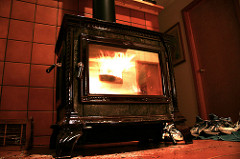 There are several important safety considerations that must go hand in hand with the use of solid fuel (coal and wood) stoves.
There are several important safety considerations that must go hand in hand with the use of solid fuel (coal and wood) stoves.
 These stoves are responsible for many fires every year. In some parts of the country, wood and coal stoves are the number one cause of house fires. In general, when properly used, coal stoves are less hazardous than wood stoves. However, they both deserve to be treated with respect.
These stoves are responsible for many fires every year. In some parts of the country, wood and coal stoves are the number one cause of house fires. In general, when properly used, coal stoves are less hazardous than wood stoves. However, they both deserve to be treated with respect.
Here are some tips for safe operation:
- Provide at least 36 inches of clearance to unprotected surfaces. Provide at least 18 inches to surfaces protected by insulated sheetmetal coverings.
- Provide at least 36 inches of clearance to all combustible materials (furniture, etc) to front, sides and rear of a wood stove.
- Keep the stove pipe clear of combustible materials by at least 18 inches.
- Mount the stove on an approved base with the feet of the stove supported at least 4 inches above the floor. The base should extend at least 18 inches in front of the stove and 12 inches to either side of the stove.
- If you have children or pets, protect them from your stove with a fence of screen.
- Install and REGULARLY TEST smoke detectors in the vicinity of wood stoves and sleeping areas in your home.
- Burn seasoned wood to avoid creosote build-up.
- Be sure to advise your insurance company that you have a wood stove in your home. They may require an inspection of the installation. Without proper notification, they may void your coverage if a fire occurs which is traced to your wood stove.
- Always have your installation inspected by a qualified individual such as the local fire marshal, a certified chimney sweep or professional engineer.
- Always have your chimney cleaned and inspected at least once a year if wood is burned frequently.
- Stove pipes that penetrate walls or ceilings must be protected by a ventilated thimble or collar that provides at least 18 inches clearance around the stove pipe.
These guidelines are based on standards established by the National Fire Protection Association (NFPA).
To assure effectiveness of your stove, always be sure it is in an open area where air can flow around it and circulate easily to other parts of your home.
Often, openings cut through floors and/or walls to adjacent spaces will do wonders to help circulate the heat from your stove throughout your house.
Also, small fans can be used to assist heat circulation.
Many stoves are providing far less heat than they are capable of simply because the air around them cannot circulate easily.
